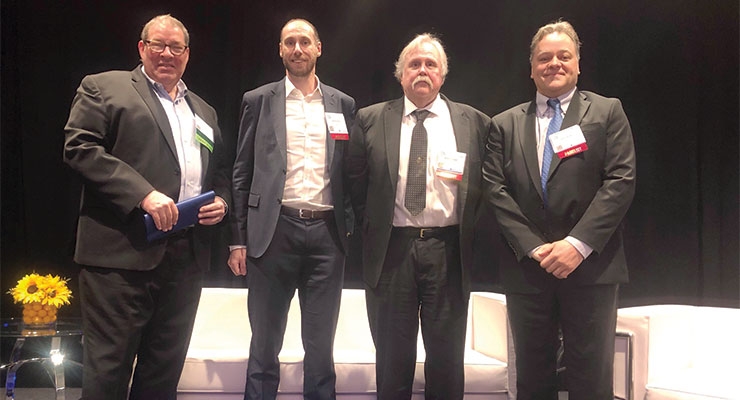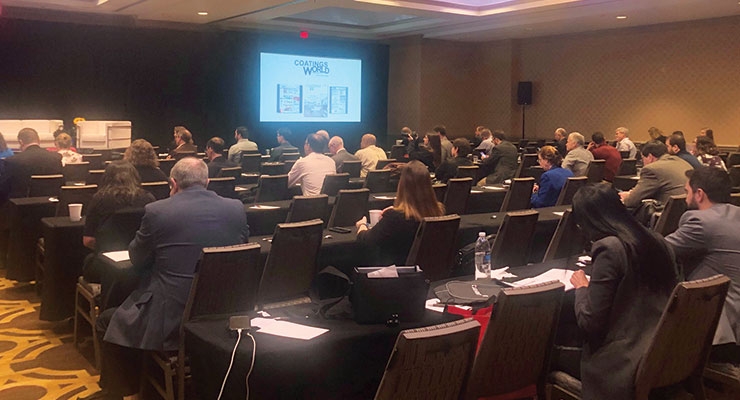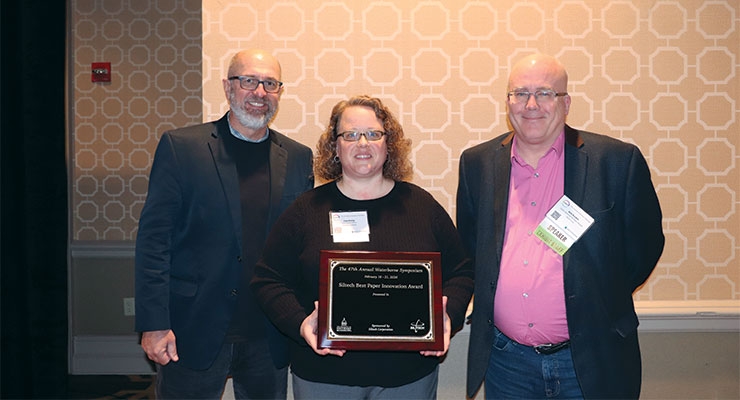Kerry Pianoforte, Editor04.15.20
The School of Polymers and High Performance Materials at the University of Southern Mississippi (USM) held its 47th Annual International Waterborne Symposium Feb. 16-21in New Orleans. The Waterborne Symposium is a technical forum for environmentally friendly coatings technologies. Proceeds from the symposium are used by USM for various elements of academic program development including junior faculty development, graduate student stipends, equipment acquisition and maintenance, and especially scholarships for undergraduate students majoring in Polymer Science. Most of these students enter the coatings or related polymer industries upon graduation. These scholarships are key to USM’s efforts to recruit the highest-achieving students into their Polymer program.
This year’s event featured 42 talks organized into several sessions related to various aspects of surface coatings: general, corrosion, resins, waterborne, pigments, additives and high solids.
Plenary Speaker, Panel Discussion, Keynote Address and Memorial Lecture
The first session commenced with plenary speaker, Prof. Dean Webster, chair, Coatings and Polymeric Materials Department, North Dakota State University and his presentation, “Towards Sustainability in Coatings Technology: Progress, Opportunities, Barriers.”
A global challenge today is the transition towards a sustainable economy. According to Webster, while there are numerous potential aspects to sustainability, some of the ones that affect the coatings industry are the use of bio-based materials, pollution reduction, energy reduction, increasing coating functionality and durability, and recycling of unused paint.
“Due to environmental regulations over the past decades the coatings industry has addressed these issues by working to reduce VOC content in paint and switching to waterborne and powder coatings,” he said. “In addition, the industry has a legacy of using renewable materials such as seed oils, cellulosics and bio-based solvents. Reductions in energy usage can be realized using radiation curing technology, as well as the elimination of intermediate baking steps in automotive production.”
More is being done to expand the use of bio-based materials, increase coating durability and longevity, create “smart” and functional coatings and replace chemicals of concern, he added.
“A question remains. How far can we go in creating a fully sustainable coatings industry,” he concluded.
Following the plenary lecture, Coatings World Publisher Dale Pritchett moderated a panel discussion on “Efficient and Sustainable Coatings.” The panel featured coatings manufacturer and environmental affairs personnel. An overview of this fast-moving and heavily regulated market from both a scientific and business perspective was presented. The panelists were Anthony Woods, segment marketing director, wood coatings, AkzoNobel; David Darling, VP, Health, Safety and Environmental Affairs, American Coatings Association; and Mark Nonweiler, president of A.P. Nonweiler Co. Inc. and USM alumnus.
The eighth annual Sidney Lauren Memorial Lecture was given by Robson Storey, of the University of Souther Mississippi, who presented “Alternative Polyurethane Coatings Cured via Azide-Alkyne Cycloaddition.”
Conventional polyurethane/polyuria polymers are crosslinked by a reaction of a polyisocyanate compound with a polyol of the polyester, polyether or polyacrylic type. Polyurethanes are used in many high-performance polymer applications, including coatings, adhesives, flexible and rigid foams and solid elastomers.
“Recently, there has been interest in polyurethane/polyuria polymers that can be crosslinked by alternative chemistries,” said Storey. “Our research group has developed a series of these polymers for coatings that cure by azide-alkyne cycloaddition.”
Technology Showcase
In addition to the main technical program, the Waterborne Symposium also included a three-day Technology Showcase. Now in its 23rd year, the showcase had exhibitors who focused on emerging technologies, new materials, innovative services and equipment for the coatings industry.
Student Poster Sessions/Awards
The Waterborne Symposium presented the Siltech Best Paper Innovation Award, the SK Mendon Best Student Paper Award and the Eastman Student Poster Awards.
Students presented their research during the Poster Session. This year’s session included 20 student posters.
The Siltech Best Innovative Paper Award was given to Lisa Kemp of Reactive Surfaces for “Carbon Capture Coatings.”
• The Thames-Mendon Best Student Paper Award was presented to Jessica Davison of the Thames Rawlins Research Group, USM for “Utilizing Hydrogels in Coatings to Understand Polymeric Materials Corrosion
Protection Processes.”
Poster awards were as follows:
Graduate Students (all in Derek Patton’s Research Group, USM)
• 1st: Benjamin Alameda - Hydrolytically Degradable Poly(β-Thioether Ester Ketal) Thermosets via Radical-Mediated Thiol–ene Photopolymerization;
• 2nd: Dana Pinson - Oxygen Barrier Properties of Polyisobutylene-Grafted Graphene Oxide/Styrene-Butadiene-Styrene Composite Films;
• 3rd: William Walker - Polymer Networks with Command Construct and Deconstruct Properties
Undergraduate Students
• 1st: Hayden Hanna - Wiggins Research Group, USM - Development of a Low-Cost Reusable 3D Printed Twin-Screw Nanofeeder;
• 2nd: Nicholas Smith – Morgan Research Group, USM - Thermo-Mechanical Degradation and Stabilization of Polyethersulfone During Melt Processing Operations
The 2021 Waterborne Symposium will be held Feb. 7-12 at the Sheraton in New Orleans.
The School of Polymers and High Performance Materials at The University of Southern Mississippi has issued a call for papers for presentation at the 47th Annual International Waterborne Symposium, February 7-12 in New Orleans.
Papers should relate to new and emerging technologies related to materials, processes, production, characterization, application and markets in the field of surface coatings. All papers should be original and represent recent advances in coatings science and related disciplines. Title, abstract and author’s names (speaker’s name underlined) should be submitted by mail, fax or e-mail no later than Aug. 15 to School of Polymers and High Performance Materials, The University of Southern Mississippi, Box 10063, Hattiesburg, MS 39406-0063; 601-266-4475; Fax: 601- 266-6265; E-mail: waterborne@usm.edu; Web: www.psrc.usm.edu/waterborne
This year’s event featured 42 talks organized into several sessions related to various aspects of surface coatings: general, corrosion, resins, waterborne, pigments, additives and high solids.
Plenary Speaker, Panel Discussion, Keynote Address and Memorial Lecture
The first session commenced with plenary speaker, Prof. Dean Webster, chair, Coatings and Polymeric Materials Department, North Dakota State University and his presentation, “Towards Sustainability in Coatings Technology: Progress, Opportunities, Barriers.”
A global challenge today is the transition towards a sustainable economy. According to Webster, while there are numerous potential aspects to sustainability, some of the ones that affect the coatings industry are the use of bio-based materials, pollution reduction, energy reduction, increasing coating functionality and durability, and recycling of unused paint.
“Due to environmental regulations over the past decades the coatings industry has addressed these issues by working to reduce VOC content in paint and switching to waterborne and powder coatings,” he said. “In addition, the industry has a legacy of using renewable materials such as seed oils, cellulosics and bio-based solvents. Reductions in energy usage can be realized using radiation curing technology, as well as the elimination of intermediate baking steps in automotive production.”
More is being done to expand the use of bio-based materials, increase coating durability and longevity, create “smart” and functional coatings and replace chemicals of concern, he added.
“A question remains. How far can we go in creating a fully sustainable coatings industry,” he concluded.
Following the plenary lecture, Coatings World Publisher Dale Pritchett moderated a panel discussion on “Efficient and Sustainable Coatings.” The panel featured coatings manufacturer and environmental affairs personnel. An overview of this fast-moving and heavily regulated market from both a scientific and business perspective was presented. The panelists were Anthony Woods, segment marketing director, wood coatings, AkzoNobel; David Darling, VP, Health, Safety and Environmental Affairs, American Coatings Association; and Mark Nonweiler, president of A.P. Nonweiler Co. Inc. and USM alumnus.
The eighth annual Sidney Lauren Memorial Lecture was given by Robson Storey, of the University of Souther Mississippi, who presented “Alternative Polyurethane Coatings Cured via Azide-Alkyne Cycloaddition.”
Conventional polyurethane/polyuria polymers are crosslinked by a reaction of a polyisocyanate compound with a polyol of the polyester, polyether or polyacrylic type. Polyurethanes are used in many high-performance polymer applications, including coatings, adhesives, flexible and rigid foams and solid elastomers.
“Recently, there has been interest in polyurethane/polyuria polymers that can be crosslinked by alternative chemistries,” said Storey. “Our research group has developed a series of these polymers for coatings that cure by azide-alkyne cycloaddition.”
Technology Showcase
In addition to the main technical program, the Waterborne Symposium also included a three-day Technology Showcase. Now in its 23rd year, the showcase had exhibitors who focused on emerging technologies, new materials, innovative services and equipment for the coatings industry.
Student Poster Sessions/Awards
The Waterborne Symposium presented the Siltech Best Paper Innovation Award, the SK Mendon Best Student Paper Award and the Eastman Student Poster Awards.
Students presented their research during the Poster Session. This year’s session included 20 student posters.
The Siltech Best Innovative Paper Award was given to Lisa Kemp of Reactive Surfaces for “Carbon Capture Coatings.”
• The Thames-Mendon Best Student Paper Award was presented to Jessica Davison of the Thames Rawlins Research Group, USM for “Utilizing Hydrogels in Coatings to Understand Polymeric Materials Corrosion
Protection Processes.”
Poster awards were as follows:
Graduate Students (all in Derek Patton’s Research Group, USM)
• 1st: Benjamin Alameda - Hydrolytically Degradable Poly(β-Thioether Ester Ketal) Thermosets via Radical-Mediated Thiol–ene Photopolymerization;
• 2nd: Dana Pinson - Oxygen Barrier Properties of Polyisobutylene-Grafted Graphene Oxide/Styrene-Butadiene-Styrene Composite Films;
• 3rd: William Walker - Polymer Networks with Command Construct and Deconstruct Properties
Undergraduate Students
• 1st: Hayden Hanna - Wiggins Research Group, USM - Development of a Low-Cost Reusable 3D Printed Twin-Screw Nanofeeder;
• 2nd: Nicholas Smith – Morgan Research Group, USM - Thermo-Mechanical Degradation and Stabilization of Polyethersulfone During Melt Processing Operations
The 2021 Waterborne Symposium will be held Feb. 7-12 at the Sheraton in New Orleans.
The School of Polymers and High Performance Materials at The University of Southern Mississippi has issued a call for papers for presentation at the 47th Annual International Waterborne Symposium, February 7-12 in New Orleans.
Papers should relate to new and emerging technologies related to materials, processes, production, characterization, application and markets in the field of surface coatings. All papers should be original and represent recent advances in coatings science and related disciplines. Title, abstract and author’s names (speaker’s name underlined) should be submitted by mail, fax or e-mail no later than Aug. 15 to School of Polymers and High Performance Materials, The University of Southern Mississippi, Box 10063, Hattiesburg, MS 39406-0063; 601-266-4475; Fax: 601- 266-6265; E-mail: waterborne@usm.edu; Web: www.psrc.usm.edu/waterborne
















